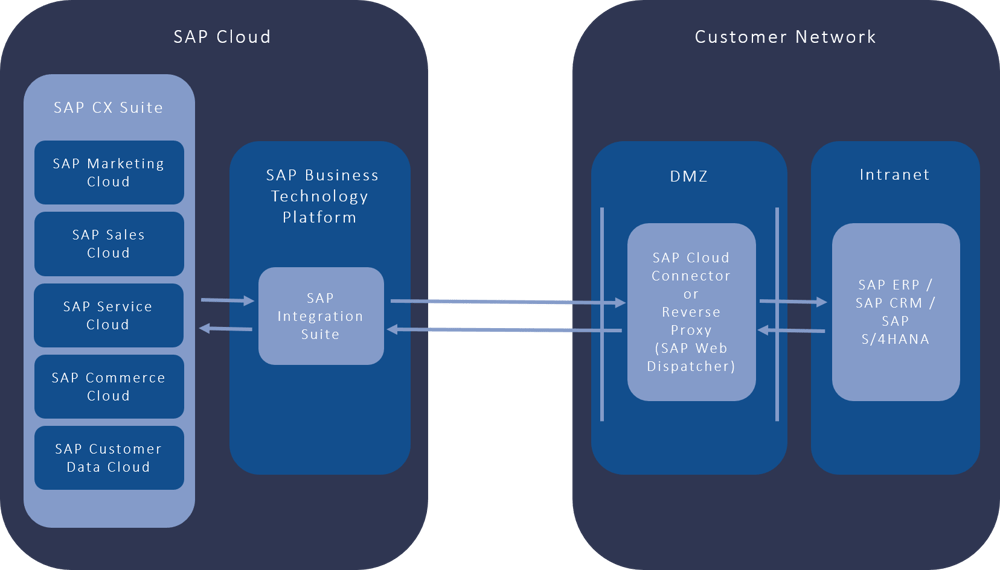SAP Customer Experience (CX) can be integrated with the on-premise solutions of SAP CRM, SAP ERP and SAP S/4HANA using integration scenarios predefined in SAP Cloud Platform Integration (CPI). Such a connection enables uni-/bi-directional synchronization of master data such as customers, contacts or products, full integration of transactional scenarios, for example opportunities, quotations and sales orders including real-time ERP pricing and representation of the ERP document flow as well as field service and support integration into SAP Service Cloud with native integration into SAP ERP, for example for service confirmations, invoices as well as contract management with SLAs and the installed base.

The integration of SAP Sales and Service Cloud (SAP C4C) with SAP ERP or SAP S/4HANA simplifies sales and service processes. When a new customer registers in your online shop, their customer data is immediately available in the backend (ERP system) without data replication. Customer service handles inquiries about an order directly in SAP Service Cloud and also has direct insight into the associated financial processes in SAP S/4HANA, for example. By not having to carry out incident acceptance, stock withdrawal for spare parts and billing in different systems, you can process service orders end-to-end. In addition, the Internet of Things (IoT) using sensors enables the automatic creation of error messages and service tickets, as well as subsequent processing and billing. In short, CRM and ERP are growing closer together.
Joint development of a strategy and roadmap
Integration preparation (system check, user onboarding, control of service providers)
Import and adaptation of SAP content (integration flows) to SAP Cloud Platform Integration
Adjustments in the SAP ERP and SAP S/4HANA system (RFC destinations, distribution model, etc.)
Adjustments in the cloud system (e.g. SAP C4C), such as mapping of communication scenarios and numbers
Customizing and mapping of codelist values
Technical connection of the systems (Cloud Connector, certificates, authentication)
Customer-specific modifications (additional fields and logics)
Joint end-to-end testing and support for go-live and cut-over
Monitoring of interfaces
Integration scenarios:
Master data: Material, business partners (e.g. customer and contact person), equipment and installations, van stock, warranties, employees
Processes: Pricing, document generation (quotations, orders), contracts, time recording/CATS, service billing
High maintenance effort in different systems: Customer data must be entered twice
Sales cannot effectively use sales opportunities because the CRM software does not provide a comprehensive database of customer activities (lack of overview of customer history with quotations, orders and purchase orders)
No central data storage, but different product master data
Sales employees have to work in several systems at the same time
Insufficient flow of information between departments
Real-time analysis of customer data and sales opportunities
Real-time access to pricing, quoting, etc.
Efficient work through integration with Microsoft Office tools
Automated provision of prices and quotations
Seamless integration of sales processes from prospect to billing
User-friendly integration of third-party systems (Outlook, GroupWise, telephony integration)
Creation of target groups and campaigns for efficient communication with your customers and prospects
Automation of sales processes:
From sales opportunity to quotation order to invoice
Sales and order figures in one system
Automatic conversion of prospects (CX) into customers (ERP)
Automation of service processes:
Automated spare parts sales (customer issue → service ticket → spare parts quotation → order → invoice
Technicians can view stock levels on the go

Leading companies from various industries rely on SAP Sales Cloud. With this solution, you digitize your sales processes and benefit from a fast, cost-effective implementation.

With the help of Web2Lead, contact data that a prospect enters in a form on your website is automatically transferred to SAP C4C and created as a new lead. This gives your sales staff the ability to generate opportunities from the leads created.

No more headaches when planning your service technicians and executing on-site assignments. SAP Field Service Management is a powerful tool for managing all aspects and challenges of your mobile workforce.
 The simulation or transfer of an order also provides an ATP (available-to-promise) result from SAP ERP. The confirmation is non-binding based on the requested date (the header date is copied to items). A simulated scheduling agreement appears in the sales order.
The simulation or transfer of an order also provides an ATP (available-to-promise) result from SAP ERP. The confirmation is non-binding based on the requested date (the header date is copied to items). A simulated scheduling agreement appears in the sales order.
 When an order is simulated or transferred, information on credit status, credit limit, and credit risk is returned from the SAP ERP system – including a warning message if the amount exceeds the limit set for the customer in SAP ERP as part of credit management. The credit status is part of the approval conditions and is determined when an order is simulated or transferred.
When an order is simulated or transferred, information on credit status, credit limit, and credit risk is returned from the SAP ERP system – including a warning message if the amount exceeds the limit set for the customer in SAP ERP as part of credit management. The credit status is part of the approval conditions and is determined when an order is simulated or transferred.
 If an order is created for a material that is created as a bill of material (BOM) in the SAP ERP system, the simulation or transfer of an order also explodes multi-level bills of material from SAP ERP. Price or quantity adjustments for a BOM are only supported on the header item.
If an order is created for a material that is created as a bill of material (BOM) in the SAP ERP system, the simulation or transfer of an order also explodes multi-level bills of material from SAP ERP. Price or quantity adjustments for a BOM are only supported on the header item.
 If a product substitution has been configured in SAP ERP, the original product entered in the sales order is replaced by a substituted product in the external pricing call. Via external pricing calls, products are substituted if the condition – example: the entered product is no longer in stock or has been discontinued – is met.
If a product substitution has been configured in SAP ERP, the original product entered in the sales order is replaced by a substituted product in the external pricing call. Via external pricing calls, products are substituted if the condition – example: the entered product is no longer in stock or has been discontinued – is met.
From our blog



Simply complete the form and submit it. We will get back to you as soon as possible.